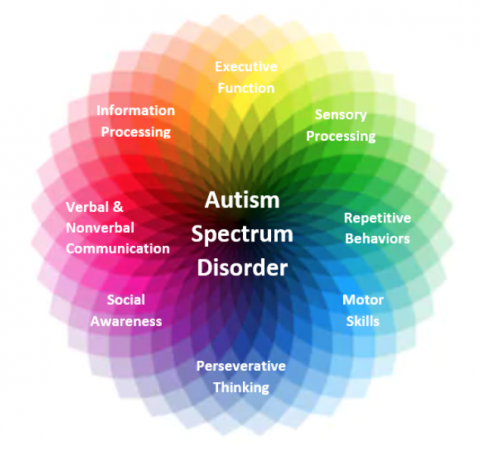The Duty of Education And Learning in Supporting Pupils with Autism: Finest Practices
The Duty of Education And Learning in Supporting Pupils with Autism: Finest Practices
Blog Article
Exploring Autism: Techniques for Effective Interaction and Communication
Reliable interaction and communication with people on the autism range necessitate a thorough understanding of their unique needs and preferences. Methods such as utilizing clear language, making use of aesthetic assistances, and fostering consistent regimens can considerably boost involvement and lower anxiety. Identifying the relevance of non-verbal signs and shared passions leads the method for purposeful links. The ins and outs of these methods disclose additional considerations that warrant expedition, especially in how they can be adjusted to diverse contexts and specific experiences. What might these adaptations resemble in method?
Comprehending Autism Range Condition
Autism Range Disorder (ASD) includes a variety of neurodevelopmental conditions identified by difficulties in social communication, communication, and repetitive behaviors. The term "range" shows the diverse indications and varying degrees of extent experienced by individuals with ASD. While some might exhibit considerable impairments, others may show high-functioning traits, permitting higher freedom in daily life.
The beginning of ASD generally happens in very early youth, with indicators frequently identifiable by age 2. Early indications might consist of delayed speech advancement, minimal eye call, and difficulties in recognizing social cues. Although the exact etiology of ASD continues to be unclear, research suggests a combination of environmental and hereditary aspects plays a critical function in its advancement.
People with ASD usually have one-of-a-kind toughness, such as enhanced focus to information and extraordinary memory abilities. However, they may deal with understanding abstract ideas and taking care of changes to regular. As an outcome, interventions and assistance tailored to private needs are important for cultivating interaction and social abilities. Acknowledging the intricacy of ASD is important for promoting awareness, acceptance, and efficient methods that help with significant communications with people on the range.

Relevance of Clear Interaction
Reliable interaction is crucial for promoting understanding and link, especially for individuals with Autism Range Condition (ASD) Clear communication not just assists in social interactions yet also enhances the person's capability to reveal their ideas, needs, and emotions. For individuals with ASD, the nuances of language can usually be testing; therefore, using uncomplicated and distinct language is essential.
Furthermore, clear communication helps in reducing frustration and anxiousness that may emerge from misconceptions. When messages are communicated in a consistent and straight manner, people with ASD are better furnished to interpret details accurately, which can significantly improve their social engagement and engagement in various setups.
Establishing regimens and using aesthetic assistances can even more boost clear communication. These techniques offer people with predictable structures that help understanding and retention of info. Additionally, actively listening and being person throughout communications promotes a supportive environment where individuals with ASD really feel valued and recognized.
Ultimately, prioritizing clear interaction not just empowers individuals with ASD yet additionally fosters more significant links with their peers, caretakers, and the broader community, leading the way for comprehensive communications and collaborative relationships. - autism
Non-Verbal Communication Techniques
Communication prolongs beyond words, and for people with Autism Range Problem (ASD), non-verbal signs play a considerable duty in interactions. Non-verbal interaction methods can include facial expressions, gestures, body movement, and eye get in touch with, every one of which work as vital elements for communicating feelings and purposes.
Recognizing see post and interpreting these non-verbal signals can Check Out Your URL enhance interactions with individuals with ASD. A warm smile or open position can produce a welcoming atmosphere, encouraging engagement. Similarly, making use of aesthetic help-- such as image cards or icons-- can link interaction voids and aid share messages a lot more effectively.
It is likewise vital to be conscious of individual room, as people with ASD may have different convenience levels relating to proximity. Observing their reactions to physical distance can notify suitable adjustments.

Developing Encouraging Settings
Creating a helpful atmosphere is crucial for fostering positive interactions and improving the wellness of people with Autism Range Disorder (ASD) Such atmospheres can substantially lower anxiety and produce a sense of security, allowing individuals to share themselves much more easily.
To accomplish this, it is important to think about sensory level of sensitivities that individuals with ASD might experience. Customizing the physical room to include soft illumination, very little background noise, and comfy seating can develop a relaxing ambience. Furthermore, making use of regular routines and clear aesthetic schedules can aid individuals prepare for transitions and lower unpredictability, more advertising convenience.
Social spaces must be structured to minimize frustrating stimulations while giving possibilities for engagement in recommended activities. Facilitating locations marked for peaceful time can additionally act as a sanctuary during moments of tension. Notably, integrating elements of option empowers people, enabling them to exercise agency in their environment.

Encouraging Social Communications
Promoting social interactions amongst people with Autism Continued Spectrum Problem (ASD) calls for deliberate approaches that focus on convenience and involvement. Developing predictable regimens can assist decrease anxiousness, making social setups more approachable. Creating organized atmospheres with defined roles and duties enables individuals to involve without the frustrating pressure of unstructured social characteristics.
Incorporating passions and strengths into social tasks can work as a stimulant for interaction. For example, organizing group tasks around shared leisure activities or topics of fascination can assist in natural conversations and connections. Additionally, utilizing visual assistances, such as pictorial schedules or social scripts, can aid in recognizing social cues and assumptions.
Modeling appropriate social behaviors is important - autism. Adults and peers must demonstrate effective communication strategies, consisting of energetic listening and turn-taking. Role-playing situations can also give a secure area for individuals to exercise these abilities
Lastly, promoting peer relationships with inclusive techniques is crucial. Motivating inclusive playdates or team getaways can produce chances for socializing in a comfy setting. By carrying out these teachers, caretakers and methods can substantially improve social communications for individuals with ASD, promoting their total social growth and health.
Verdict
To conclude, effective communication and interaction strategies are necessary for sustaining people with Autism Spectrum Disorder. Highlighting clear language, integrating non-verbal hints, and developing predictable regimens dramatically boost interaction and decrease anxiety. Developing helpful settings fosters secure social interactions, while encouraging shared passions helps with meaningful connections. Ultimately, these approaches empower individuals with autism to browse social landscapes, advertising their general health and allowing the growth of enduring relationships.
Efficient communication and interaction with people on the autism spectrum necessitate a thorough understanding of their unique requirements and choices. Clear interaction not just assists in social interactions but also boosts the individual's ability to share their emotions, thoughts, and demands.Fostering social interactions among individuals with Autism Spectrum Condition (ASD) needs willful approaches that focus on convenience and interaction. By implementing these caretakers, techniques and instructors can significantly boost social communications for individuals with ASD, promoting their total social growth and well-being.
In conclusion, efficient interaction and communication strategies are necessary for sustaining people with Autism Range Disorder.
Report this page